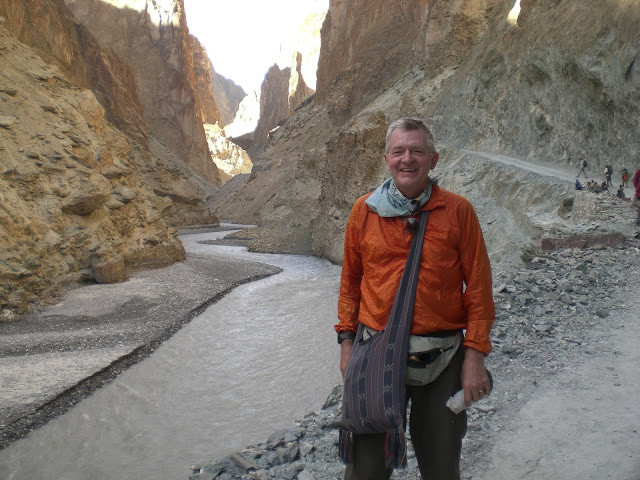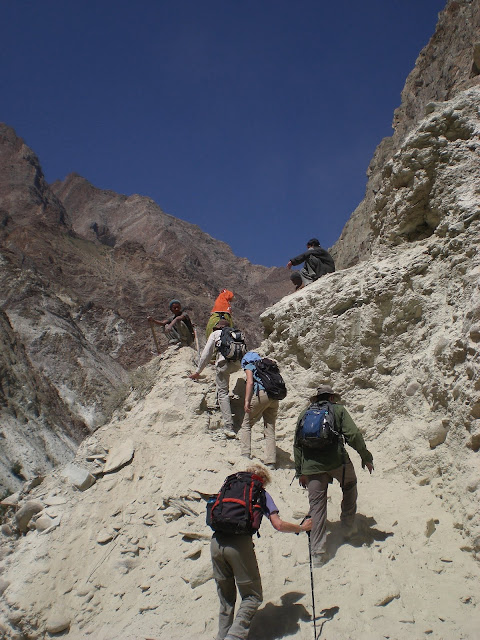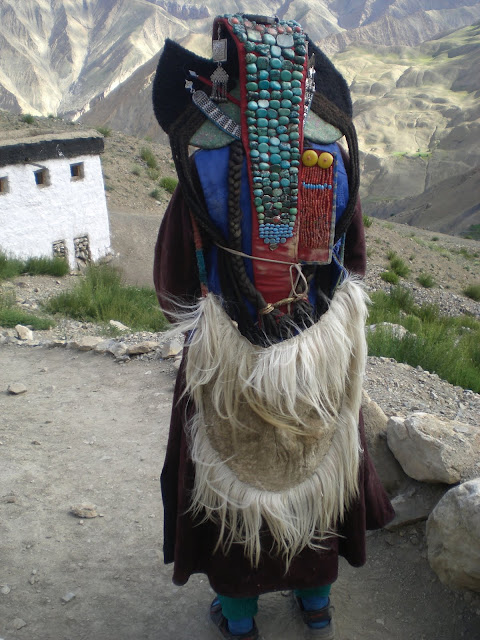On June 25, 2008, I left Seattle to India by using 80,000 American Air frequent flyer miles. I joined up with the Crooked Trails group in Delhi after 5 days on my own. After a short tour of Delhi, we flew north to Leh on Jet Air on the 30th, which became our jumping-off spot to visits to the Gompas or monasteries of Thiksey, Hemis, Alchi, and Lamayuru.
Neighborhoods, in Delhi where I was staying before joining up with the Ladakh group, were preparing for yet another festival.


Women's Dance
Neighborhoods, in Delhi where I was staying before joining up with the Ladakh group, were preparing for yet another festival.


Leh is in the Ladakh region of India that is sandwiched between Pakistan and China along the Himalayan Mountain Range where the dominant religion changes from Hinduism to Buddhism.
Leh is filled with backpacker and hiker accommodations, outfitters, restaurants, local markets, and historical sites.
Our guesthouse was very pleasant with great views.




While in Leh, we visited this boarding school for the children in the Ladakh Region that was started by a monk from Lingshed where we would be visiting, doing some community service, and doing a homestay.

Tammy Leland, co-owner of Crooked Trails Travel, had met the monk at a conference and he had invited her to visit him sometime. She did several years ago, and that visit has evolved into a travel adventure for travelers like me.
Here is the Monk

Tammy with three students.


On the road to the start of our trek, we stopped at a few monasteries along the way. The monks at the Hemis Monastery were practicing for a festival when we passed through there.


Here is the library of Tibetan prayers.

The gravel roads were fairly good and the bridges crossing the rivers held up as we made our way up the river valleys to Panjilla. Despite the remoteness, tensions between India and Pakistan continue to be high and we came across many Indian armed forces.



We began trekking at Panjilla by heading up the Yapola River Valley along with a road construction site that was being blasted out of the rocky sides of this narrow river valley. The horsemen had already left with our luggage when we started trekking.


Within the first day, we lost our first trekker who suffered from heat exhaustion and altitude sickness so Tammy had to give him first aid and then escort him back down to safety and Tammy rejoined us the following afternoon.
We stopped here for lunch and tea while our local guide Lobsang visited with some old friends that she had not seen for three years.
Every night we set up our camp, the villagers would come to visit with us.
Vegetation became sparse as we approached the first of four mountain passes that were over 15,000 feet high. I am with the group in the lead and if you look in the middle-lower left portion of the photo below, you can see the other hikers I am with.
We celebrated at each of the four passes we crossed.
Deepen Rai, our cook, and Lobsang, our guide at Sengge Pass. Deepen died in a plane crash in Nepal in 2012. He was such a warm-hearted and gentle soul who will be missed by all who have known him.
This is the approach to Photoskar where we would spend the night.
We are preparing to leave camp for the day and Peter is getting some help from a local villager.
We are coming to another small river crossing before we head up another pass.
Icy cold glacier water gave us a real wake up.
Yet another pass to go over and fortunately we have not encountered any snow.
Lobsang meets up with our horse train that is carrying our luggage and supplies.
You can see the switchbacks some of us hiked down. I and a few others took to the gully to the right of the switchbacks and rock glissaded down this slope.
This villager came our camp by this lake with her bucket of yak milk she had just gotten from the village yak herd.
Time for me to string up some prayer flags before we head down to Lingshed.
We trekked for six days and stayed near the following small villages along the way: Panjilla, Honopatta, Photoskar, Sengge, and Skiupata. After trekking over four mountain passes that were over 15,000 feet, we came to Lingshed where we would do homestays with villagers for a week before returning to Leh.
Lobsang, Bernice, Erik, and I are celebrating the arrival at Lingshed. This is Lobsang's home village which she has not been to for about 3 years so she is happily looking forward to many reunions. The villagers know that we are coming as the word passes up and down the trail. As we came down into the village we were met by many of Lobsang's friends and neighbors.



The cultural center of Lingshed hosted us with a party that included traditional garb for us, dances, and lots of food and chang drinks.

Some of our group is posing with the traditional garb of the region. Back row: me, Peter, Erik, and front row: Denise, Tammy, and Bernice.

The ladies are surely laughing at us---maybe we have the hats on backward or something else.

My host family

This is their kitchen and living area as they prepare tea for us.

This is the room that Erik and I shared for sleeping while in Lingshed. It is probably our hosts' normal bedroom. Nearby they have an indoor composting toilet and the resulting compost is used to fertilize the vegetable gardens.

Morning Prayers
The monks sponsored a festival that celebrated the finishing of the reading of some sacred Tibetan prayers. The monks chanted while the villagers feasted on tsampa, chapatis, barley balls, butter tea, and copious amounts of chang--fermented barley beer. After the feast, the villagers went to the field below the monastery and gathered for three days of music, dancing, and drinking endless cups of chang.
Making Chapati for the Monastery festival.
While in Lingshed, we helped some of the villagers build their homes and participated with the local cultural troop in feasting, singing, and dancing. Following that, we visited the local nunnery and school.
We are taking a tea break after helping build an addition to a villager's home. L to R: Denise, Tammy, Bernice, Angela, Erik, and Dorjay--Lobsang's spouse who was one of the horsemen who hauled our luggage and tent and cooking supplies.

My host stands in front of the Tibetan prayer books at the monastery.
The villagers wear these turquoise peraks and red corals that have been handed down from their relatives and the shaggy wool skirt like garb is useful for comfortable sitting on the cold and dirty ground.
During this festival, they alternate between having the women dance and then the men. The dancer in the front is given white silk scarfs or katas as a sign of honor and respect.


Our guide, Lobsang, was given the biggest honor as shown by the huge number of katas that the villagers have draped around her shoulders.
She is the sister of our host who has prepared our lunch of nan and dal.

Our host is meeting his wife who has just been honored by the villagers for being foster parents of children who are either orphaned or are attending the local school and boarding at their home. The couple is childless and they enjoy hosting these young children. He is also enjoying carrying my "man" bag.

Notice a large number of katas that are draped around my host as she finishes up her dance. Shortly after she finished this dance, the men insisted that I lead one of the men's dances which I did. I gathered up a number of katas from many of the women, but nowhere near what either Lobsang or my host had received. After I finished dancing the men took me to a small cavern where they cheered me on with lots of chang--semi-fermented local beer.
My Happy Host
While Erik and I did a homestay, Peter stayed at the monastery and somehow became a monk. Check his chant of o mani pani hom at the end of this video clip of our journey.
This big prayer wheel yields big prayers.
Ladakh or “Little Tibet” is a beautiful desert region high in the Western Himalayas. People live in the narrow strips of irrigated lands clinging to the rivers that come down from the mountain glaciers. This rugged region is one of the last undisturbed Tantric Buddhist populations on earth. From November to May, Ladakh is almost completely cut off from the outside world because of the harsh winter weather approaching minus 40 degrees.
Necessities like sugar, wood, kerosene, and soap must be brought from the outside during some months, All of it is carried on foot, or by pack animal on a four-day walk from the nearest road. They have no electricity, nor running water. Medical care is provided by an Amchee, a practitioner of folk medicine.


During our trek, we encountered high mountain passes, deep gorges, wild rivers, open plains, ancient monasteries, and remote villages. We experienced a few days of 90-degree weather followed by rain and wind in 40-degree weather. After the rains passed, we experienced the bluest skies during the days and star-filled nights.
We then headed back and came across this horse caravan that was bringing in supplies to Lingshed.

The return was sunny so we were able to relax at the top of some of the passes on the way back.

A few of the Lingshed kids joined us for the return to Leh so they could attend school. This kid is helping Peter keep his head bald with a bit of close shaving.

Soon the horsemen will continue on the longer route while we take the shortcut that horses cannot travel on because the Yapola river crossings were too sketchy.




Our horsemen rejoined us at the end of the trek in Panjilla. After three weeks of trekking without seeing or hearing any vehicles or airplanes, we again boarded our SUVs for our return to Leh.


Lobsang and Dorjay are reunited with their child who had been taken care of by Lobsang's mother in Leh.

We then flew back to Delhi and enjoyed racing downtown in these tuk-tuks to see a Bollywood movie and eating at a nearby restaurant.


In the morning, we visited a Sikh Temple and watched them count money donations, feed the hungry--we even made some naan while there, and worship.



We went to a sari shop where we all bought some saris. I got one for my wife and one for my daughter.

View from the Jama Masjid.

We then took a quick trip to Agra to see the Taj Mahal. While there a model was doing a photo shoot and she let me take her pose. A beautiful end to my Ladakh Adventures.

Cost of Trip
The total cost of the Ladakh Trek was $3,175 for 30 days or $106 which included the Crooked Trails Tour that cost $2,890 for 25 days. The food costs were $145 for 12 days or $12 per day. The lodging costs were $84 for 5 nights or $16 per night. The travel and tour costs were $2,946.
Subscribe to my YouTube Channel
I have recently uploaded all of my travel videos to YouTube now that they allow longer uploads. I have also added other shorter travel videos.
That link is https://www.youtube.com/c/huntforgold
If you do go there, please subscribe to my video channel since it will help me eventually get some income there and help with my future travels.





































No comments:
Post a Comment